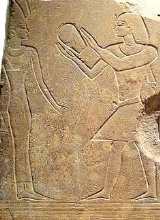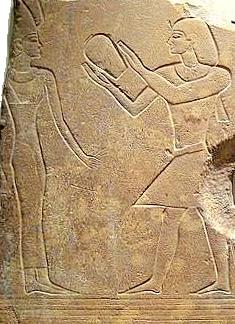
Satis
Encyclopedia

Egyptian mythology
Ancient Egyptian religion was a complex system of polytheistic beliefs and rituals which were an integral part of ancient Egyptian society. It centered on the Egyptians' interaction with a multitude of deities who were believed to be present in, and in control of, the forces and elements of nature...
, Satis (also spelt Satjit, Sates, Satet, and Sati) was the deification of the flood
Flood
A flood is an overflow of an expanse of water that submerges land. The EU Floods directive defines a flood as a temporary covering by water of land not normally covered by water...
s of the Nile River, and her cult originated in the ancient
Ancient Egypt
Ancient Egypt was an ancient civilization of Northeastern Africa, concentrated along the lower reaches of the Nile River in what is now the modern country of Egypt. Egyptian civilization coalesced around 3150 BC with the political unification of Upper and Lower Egypt under the first pharaoh...
city of Swenet, now called Aswan
Aswan
Aswan , formerly spelled Assuan, is a city in the south of Egypt, the capital of the Aswan Governorate.It stands on the east bank of the Nile at the first cataract and is a busy market and tourist centre...
on the southern edge of Egypt
Egypt
Egypt , officially the Arab Republic of Egypt, Arabic: , is a country mainly in North Africa, with the Sinai Peninsula forming a land bridge in Southwest Asia. Egypt is thus a transcontinental country, and a major power in Africa, the Mediterranean Basin, the Middle East and the Muslim world...
. Her name means she who shoots forth referring to the annual flooding of the river. She was an early war, hunting
Hunting
Hunting is the practice of pursuing any living thing, usually wildlife, for food, recreation, or trade. In present-day use, the term refers to lawful hunting, as distinguished from poaching, which is the killing, trapping or capture of the hunted species contrary to applicable law...
, and fertility
Fertility goddess
A fertility deity is a god or goddess in mythology associated with fertility, pregnancy, and birth. In some cases these deities are directly associated with sex, and in others they simply embody related attributes...
deity who was seen as the mother of the Nile River, Anuket
Anuket
In Egyptian mythology, Anuket was originally the personification and goddess of the Nile river, in areas such as Elephantine, at the start of the Nile's journey through Egypt, and in nearby regions of Nubia....
, and a protector of southern Egypt.
One of her titles was She Who Runs Like an Arrow, which is thought to refer to the river current, and her symbols became the arrow and the running river. Satis was pictured as a woman wearing the conical crown
Crown (headgear)
A crown is the traditional symbolic form of headgear worn by a monarch or by a deity, for whom the crown traditionally represents power, legitimacy, immortality, righteousness, victory, triumph, resurrection, honour and glory of life after death. In art, the crown may be shown being offered to...
of Upper Egypt
Upper Egypt
Upper Egypt is the strip of land, on both sides of the Nile valley, that extends from the cataract boundaries of modern-day Aswan north to the area between El-Ayait and Zawyet Dahshur . The northern section of Upper Egypt, between El-Ayait and Sohag is sometimes known as Middle Egypt...
, the Hedjet
Hedjet
Hedjet is the formal name for the White Crown of pharaonic Upper Egypt. The crown was white and, after the unification of Egypt, it was combined with the Red Crown of Lower Egypt, with the delta to form the Pschent, the Double Crown of Egypt...
, with gazelle
Gazelle
A gazelle is any of many antelope species in the genus Gazella, or formerly considered to belong to it. Six species are included in two genera, Eudorcas and Nanger, which were formerly considered subgenera...
or antelope
Antelope
Antelope is a term referring to many even-toed ungulate species indigenous to various regions in Africa and Eurasia. Antelopes comprise a miscellaneous group within the family Bovidae, encompassing those old-world species that are neither cattle, sheep, buffalo, bison, nor goats...
horns, or as an antelope, a fast moving creature living near the banks of the river in the southern portion of Ancient Egypt
Ancient Egypt
Ancient Egypt was an ancient civilization of Northeastern Africa, concentrated along the lower reaches of the Nile River in what is now the modern country of Egypt. Egyptian civilization coalesced around 3150 BC with the political unification of Upper and Lower Egypt under the first pharaoh...
. She also was depicted with a bow and arrows.
Other interpretations say her primary role was that of the war goddess, a guardian of Egypt's southern (Nubian) frontier and killing the enemies of the Pharaoh with her arrows.
She usually is depicted as holding an ankh
Ankh
The ankh , also known as key of life, the key of the Nile or crux ansata, was the ancient Egyptian hieroglyphic character that read "eternal life", a triliteral sign for the consonants ʻ-n-ḫ...
also, due to her association with the life giving flooding of the Nile. Consequently, it is true that Satis acted as a fertility goddess, thus granting the wishes of those who sought love. Satis is also described as offering jars of purifying
Ritual purification
Ritual purification is a feature of many religions. The aim of these rituals is to remove specifically defined uncleanliness prior to a particular type of activity, and especially prior to the worship of a deity...
water.

Elephantine
Elephantine is an island in the River Nile, located just downstream of the First Cataract at the southern border of Ancient Egypt. This region is referred to as Upper Egypt because the land is higher than that near the Mediterranean coast. The island may have received its name because it was a...
(the First nome
Nome (Egypt)
A nome was a subnational administrative division of ancient Egypt. Today's use of the Greek nome rather than the Egyptian term sepat came about during the Ptolemaic period. Fascinated with Egypt, Greeks created many historical records about the country...
of Egypt
Egypt
Egypt , officially the Arab Republic of Egypt, Arabic: , is a country mainly in North Africa, with the Sinai Peninsula forming a land bridge in Southwest Asia. Egypt is thus a transcontinental country, and a major power in Africa, the Mediterranean Basin, the Middle East and the Muslim world...
), indeed the centre of her cult was nearby, at Sahal, another island of the Nile. Since she was most dominant at the southern end of Egypt, she became regarded as the guard of Egypt's southern border with Nubia
Nubia
Nubia is a region along the Nile river, which is located in northern Sudan and southern Egypt.There were a number of small Nubian kingdoms throughout the Middle Ages, the last of which collapsed in 1504, when Nubia became divided between Egypt and the Sennar sultanate resulting in the Arabization...
.
Satis's child was Anuket
Anuket
In Egyptian mythology, Anuket was originally the personification and goddess of the Nile river, in areas such as Elephantine, at the start of the Nile's journey through Egypt, and in nearby regions of Nubia....
, goddess of the Nile River herself, who formed the third part of the Elephantine triad of deities when formed.
After Khnum became considered a form of Ra
Ra
Ra is the ancient Egyptian sun god. By the Fifth Dynasty he had become a major deity in ancient Egyptian religion, identified primarily with the mid-day sun...
, Satis became known as the Eye of Ra. This eye had begun as the wedjat, advanced to being called the Eye of Horus
Eye of Horus
The Eye of Horus is an ancient Egyptian symbol of protection, royal power and good health. The eye is personified in the goddess Wadjet...
, and finally being called the Eye of Ra as the importance of the cults changed the nature of the pantheon
Egyptian pantheon
The Egyptian pantheon consisted of the many gods worshipped by the Ancient Egyptians. A number of major deities are addressed as the creator of the cosmos. These include Atum, Ra, Amun and Ptah amongst others, as well as composite forms of these gods such as Amun-Ra. This was not seen as...
during the long history of Ancient Egypt.

